User onboarding is a team sport: Who should work on what

.png)

.png)
Onboarding is the most important stage of a user's experience with your service. It's when they learn to love your product or they drop out. That means learning from users and iterating throughout the onboarding experience is a crucial growth strategy. We've seen user onboarding improvements drive Week 1 retention up to 75% from around 60%, and that growth continues through the customer lifecycle.
But so much goes into creating an onboarding journey that it's difficult to tell whose jurisdiction it falls under. Does the buck stop with the product manager? Is it up to the development team to maintain an exciting onboarding UI that keeps folks from churning? The short answer is that everyone has a hand in onboarding. The slightly longer answer is that without connecting the work of different departments — from product to sales to customer happiness — your first-run user experience will fail to surround the user in the value of your product.

For the user entering and discovering a new product, they're not thinking of their experience as “onboarding.” They're just trying something new, hoping it makes their life easier. For the new user, onboarding is the product.
Onboarding can't just be quilted together from the work of different departments. It must be holistic. If it's not, users will get a fractured experience. Marketing will sit in their email. Product will sit in their UI. Sales will drop in every so often and try to convince them that they need to upgrade. While the specific tasks and responsibilities may vary slightly from organization to organization, teams need to work together to build a great user experience.
In fact, in our recent survey of 350 SaaS professionals, we learned that teamwork and collaboration was the single biggest factor to delivering a great product-led experience. As Ramli John, Content Director at Appcues and author of Product-Led Onboarding, puts it:
"Truly great product-led experiences emerge from empowered, fully cross-functional teams. Instead of centering PMs in every decision, actual product-led growth requires a collaborative, team effort, where every function supports each other to deliver a seamless customer experience."
When we examined which team budget was responsible for orchestrating product-led experiences, it was clear that it was pretty much all of them. Regardless of which team is footing the bill, everyone is contributing.
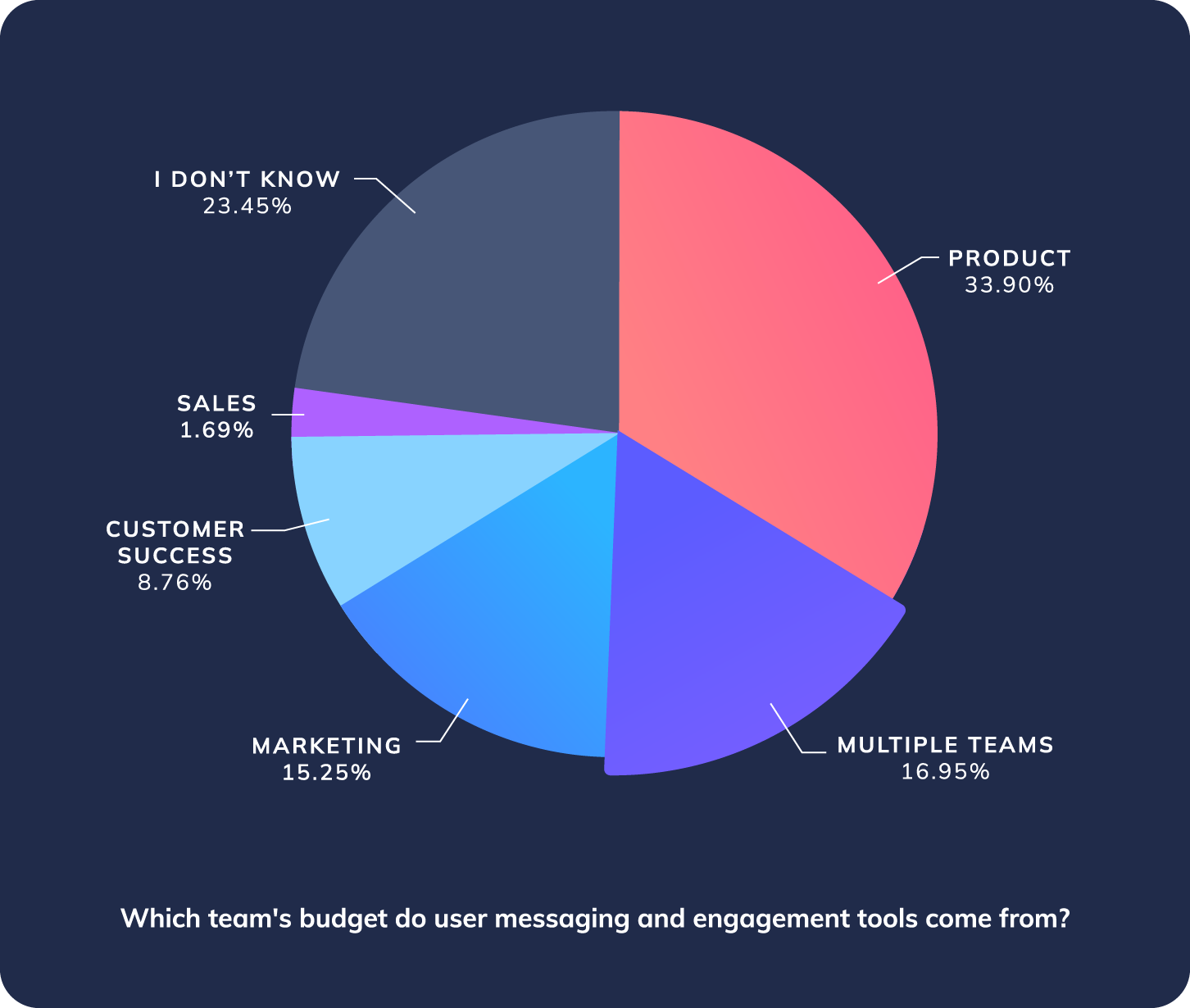
Product managers own the in-app user onboarding experience. It is their job to design and adapt the product to guide new users. They need to be able to recognize when something is failing and figure out how to change it. And every decision they make must drive users not just to try the product but to adopt it into their lives.
The onboarding journey should show your product at its best, not just a highlights reel. Product managers should map points in the onboarding experience to enlighten users. Each point of the onboarding journey must coach the user in how to take the best advantage of features, while allowing them to actually use the product.
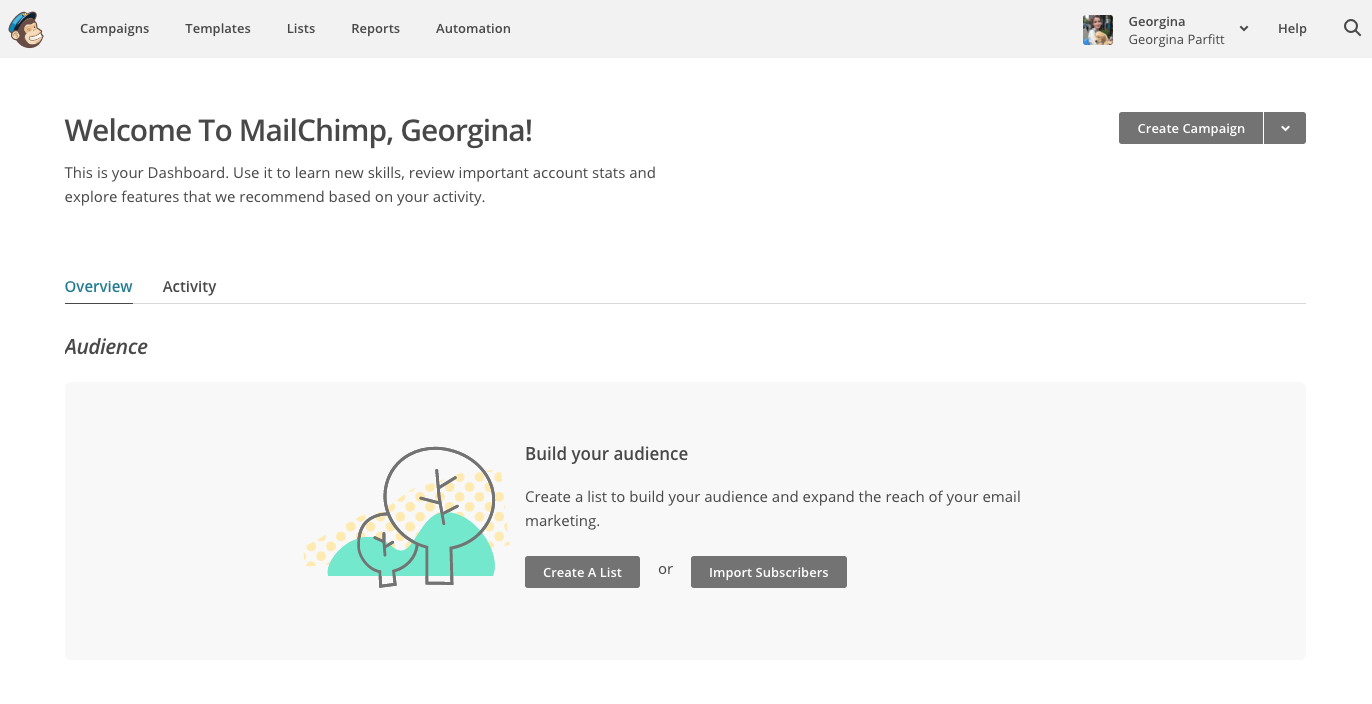
MailChimp's onboarding shows a great understanding of the user journey. The user is presented with a simple binary choice to “Create A List” or “Import Subscribers.” Each option is engineered to get new users up and running and take meaningful actions, so that they'll send MailChimp newsletters as quickly as possible.Just as importantly, MailChimp immediately greets users by their first name. While it's a simple strategy for an effective welcome page, it creates a personalized experience from the start and makes users feel more welcomed.
Your in-product onboarding is crucial for quickly getting users to the value of your product. But users don't live inside your product—they've got other things to do. That's where marketing steps in. A triggered lifecycle email campaign during onboarding drives users back into the product by drawing users' attention to core actions they can complete.
Unfortunately, users aren't hanging out in your app all the time. Marketers are that vital link, drawing the user from their busy life back into the product. When used right, onboarding emails can distill the information users learned in-product into single, usable gems that drive deeper engagement.
When building the in-product onboarding experience alongside onboarding emails, it's important to remember that both serve different purposes. In-product welcome pages, like the MailChimp for example, steer users towards their first aha! moment. Meanwhile, welcome emails aren't the place to teach users all about your product. Rather, they're an opportunity to share your company's vision and reveal additional sources of value.
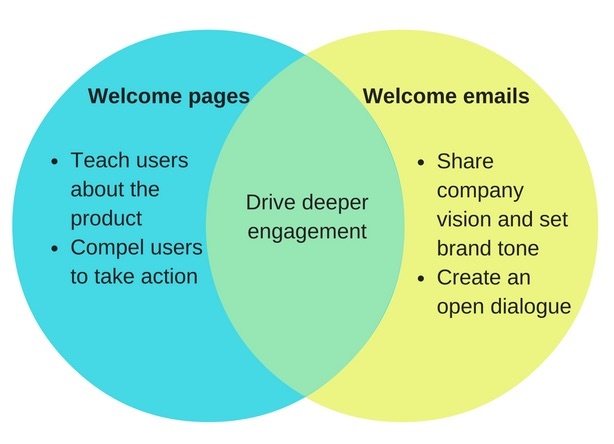
Buffer uses a short-but-powerful onboarding welcome email to establish their company vision, encourage users to reach out, and direct the user's attention to “one single tip for getting the most from Buffer.” The user is much more likely to click this single button than choose from a range of buttons all offering different things.
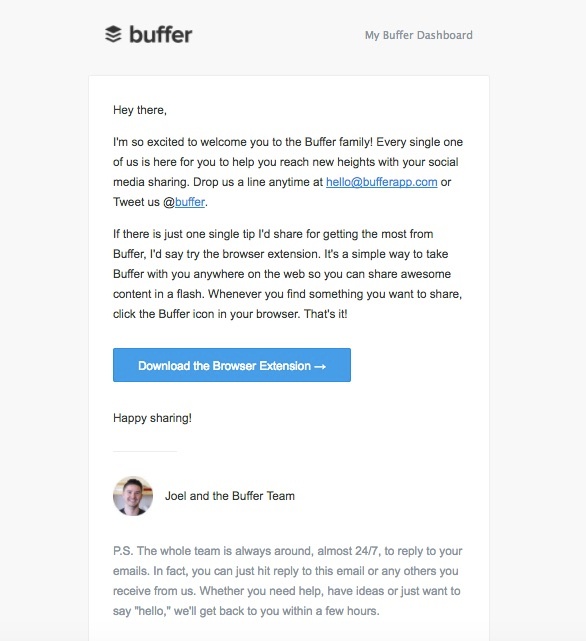
Great marketing work creates a personal and emotional connection. Because Buffer addresses this email from a real person, Joel, the user now has a personal connection at the company. They're more likely to interact, knowing they can get tailored help when they need it.
When your sales team reaches out to potential customers, the vision of your product is in their hands. Sales people can take special care of individual users and lay out expectations for further parts of the product, like premium features and subscription benefits, motivating them to build a deeper, more frequent habit with your service.
Sales teams can use demos to offer users customized guides through the product. Armed with engagement data from product and marketing, they can pick out details that are relevant to particular users and give highly-targeted demos. This is how Sales can keep building on the relationships initiated by the marketing team. At Appcues, we use a slideout message to connect users to an account manager:
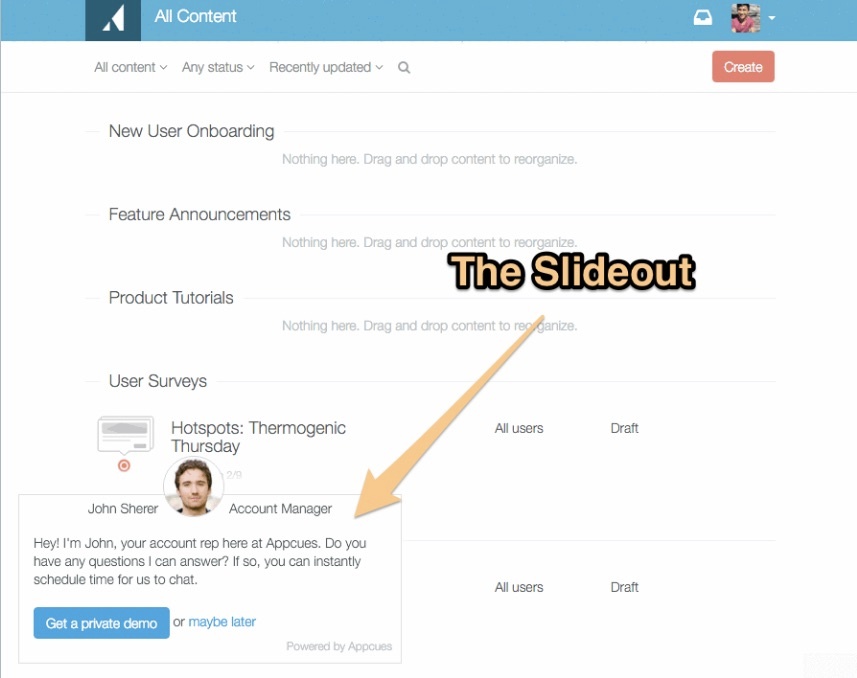
Because the message appears in-product during the trial without being invasive, people engage with it. After we implemented this slideout, we started seeing a 50% increase in sales demos, because it targets users in-app, at a specific point in their journey where they’re likely to want more information.
The people responsible for customer success and happiness should have a huge hand in the onboarding process. Understanding users' wants and needs is crucial during onboarding, and customer success teams are usually equipped with the empathy and product know-how necessary to help users get immediate value.
It's up to customer success to reach out to customers, measure how they’re feeling as they progress through onboarding, and help the product team to iterate on those results.This is how Harvest uses a quick email survey to get feedback from users after their free trial has expired. This email is great for several reasons:

This email increases the chance that recipients will continue using their Harvest account. The list of actions presents users with clear options in concrete language. It gives them a chance to request extra features or more time to trial the product. As a result, Harvest's happiness team learns what it needs to do to keep this customer around. As they work to make customers happier, the support team should be feeding back to marketing, sales, and product to integrate customer feedback into product improvements. Every support question and survey response should be recorded and relayed to where it's needed to enhance the user experience.
For the customer, onboarding should be an exciting and immersive experience, where they're learning new things and taking action to improve their lives through your product. But behind the scenes, there are many hands making this work. One key group that's left out of onboarding is dev. While dev time and skills are crucial to the success of any fast-growing software product, they're often too focused on writing code that's core to the product. Even if user onboarding is on the roadmap, developers probably don't want to be in charge of constantly experimenting and optimizing user onboarding.
Get your team creating great onboarding by equipping everybody with great resources. Take advantage of our User Onboarding Academy as an index. Pick out tips for the challenges that come up, find support for decisions and changes of focus, and see how other companies have transformed their onboarding. It's only by sharing lessons and insights among your team that you'll create a complete experience for your users.
Want to become a User Onboarding Master? Check out our free User Onboarding Academy!